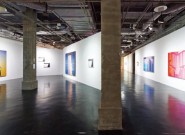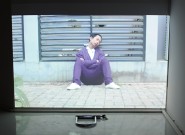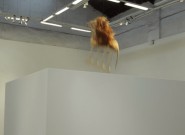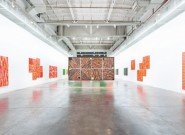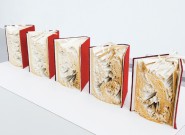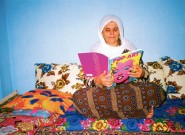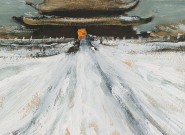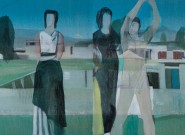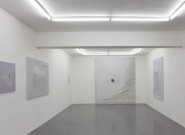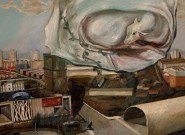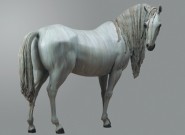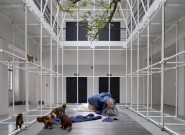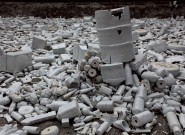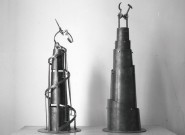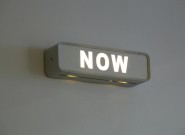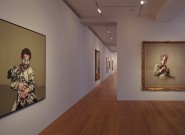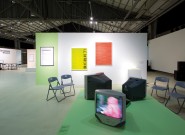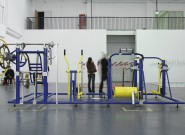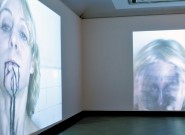For those who have been paying attention to or are simply familiar with Jiang Zhi’s artistic practice this past decade, signs and echoes of Jiang’s previous works abound in the exhibition “A Thought Arises,” whether in the exquisite depth of the video installation The Light of Transience or the poetic wisdom expressed in the needles…
Read MoreOutside an upscale shopping district in the center of Wuhan, following a graffiti-covered wall around an inconspicuous corner, one may find the entrance to Chi K11 Art Space. The small elevator, with only enough elbow room for two people, does not hold a single clue to indicate that there might be an art space upstairs,…
Read MoreMadeIn Company have released a new set of merchandise in an exhibition that cannot be said to differ from their many and frequent shows in the past. The major works (perhaps better described as products) of “Physique of Consciousness,” held at Long March Space in Beijing earlier this year, consisted of a set of physical…
Read MorePerhaps not even Tu Hongtao himself anticipated that the transformation of his painting— which he had been repeatedly putting off— would culminate in this solo exhibition at Iberia Center for Contemporary Art. During the unusually long preparation period for this exhibition, instead of knocking out paintings to fill a large space, as he has was…
Read MoreIn 1986, a 24-year-old youth did two things. First, he changed his name from Ding Rong to Ding Yi. Second, he drew a grid pattern with the letter X on an 84-square-centimeter canvas and called it Taboo. These two seemingly unrelated things, proceeding from the consciousness of this one person, would put into practice the…
Read MoreEven though the introduction to the exhibition states that the formalization of art and realism have been cautiously formulated as coexisting in relation to each other, there is still a strong whiff of something different from the verb in the English title of this exhibition. In the early 1950s, formalized art and realism in China…
Read MoreMajor historical moments made 1989 a famous year of change: the Russian withdrawal from Afghanistan, the fall of the Berlin Wall, the violent suppression of student movements elsewhere. No wonder either that the following implosion of the Soviet bloc, the end of the Cold War and the German reunification appeared primarily as a historical victory of the West and the capitalist system. Today,…
Read MoreArt from China is highly fashionable in New York, but attention to one or another current star too often neglects the art-historical question of how contemporary art emerged at the dawn of Opening and Reform. This exhibition looks at three distinct movements— the No Name Group, the Stars, and the Grass Society—which functioned as agents…
Read MoreThe paintings of the 51-year-old French artist Marc Desgrandchamps call to mind a number of key figures in the Western artistic tradition: Manet, Cézanne, Degas, or even the sculptures and architecture of ancient Greece. Traces of the styles of past masters appear continually in his works, though they still retain characteristically modern touches. Desgrandchamps concerns…
Read MoreThe predominance of a grayish-white has always been the most salient feature of Zhang JBai’s paintings. Even his depictions of concrete subjects, such as his series of portraits, possess a certain imagery. In his new exhibition, “I’ve Got Something,” he continues to ruminate on this same faintly discernible spatial relationship on the canvas. His is…
Read MoreUp until now, Huang Liang’s paintings have been dominated by narratives of illness, or more specifically, that of his own bout with a misdiagnosed case of lung cancer. Suffering from respiratory ailments, his doctor’s faulty diagnosis landed Huang in two years of treatment, a time when he says he lost all hope and lived in…
Read MoreFollowing the exhibition, nearly all press coverage of “Will Things Ever Get Better?” referred to the figure of the horse. At the show, the horse was portrayed as utterly dejected and sad, bearing the look of intense scrutiny and existential doubt typical of a philosopher. Even though the portrayal of this slim yet hearty-looking horse…
Read More“You think you can just ask Confucius?” A group of his inquisitive pupils once said, and not un-rightly. It is therefore likely that Zhang Huan’s “Question” seeks to lead the viewer in proceeding from “Confucius” as symbolic subject, discovering new facets to this signifying symbol, catching glimpses of the relationships between Confucius and the self…
Read MorePorcelain chips and fragments produced by kilns across hundreds of years accumulate in piles along the banks of the Chang River in Jingdezhen, creating a tableau akin to an archeological dig of a manufacturing site. These piles are washed, rinsed, and sometimes exposed by the rise and fall of the tides in a perpetual water…
Read MoreLu Lei’s works possess an intricacy of form beckoning association with the Baroque style; invocative of the sublime and the spiritual, they are as rich with imagination and movement as they are echoing with a sort of hallowed purity. In his newest solo exhibition “Floating Ice Biography,” Lu selects to utilize materials and ideas that…
Read MoreWhen composer John Cage performed the silent composition 4’33 in 1952, his idea was that silence was never silent, but a space filled with unintentional, musical sounds. Artist and musician Su-Mei Tse’s solo exhibition “Lapses of Time” evokes this notion in the treatment of the exhibition space, here divided into two rooms. Starting with the…
Read MoreFollowing on Zeng Fanzhi’s major exhibition of sculptures and mural-sized paintings at the Rockbund Art Museum in Shanghai last year (see review, LEAP 6), this tightly curated show at Gagosian’s Hong Kong space— the first there dedicated to a Chinese artist— possessed all the air of a retrospective. Collating Zeng Fanzhi’s “wide-ranging depictions of the…
Read MoreAlthough the majority of the research that culminated in the “Little Movements” exhibition revolves around Chinese contemporary art, the three young researchers-cum-curators—Liu Ding, Carol Yinghua Lu, and Su Wei—do not attempt to uncover or define any so-called special Chinese characteristics in their subjects. Instead, they opt to adopt a global view of art events, a…
Read MoreFor its fifth installment, the Chengdu Biennale was transformed from a privately funded exhibition into a state-run cultural event. In the eyes of many, this example of “re-nationalization” hints at an official recognition of the value of events of this kind; to adopt the vocabulary of business marketing, the Chengdu Biennale as we know it…
Read MoreIn September 2011, the fourth Guangzhou Triennial opened as scheduled—amidst considerable doubt, followed by responses increasingly bleak in their disappointment. First in 2002 with Wu Hung’s conception for the first triennial—“Reinterpretation: A Decade of Experimental Chinese Art (1990-2000)”—next in 2005 with Hou Hanru’s “Beyond: An Extraordinary Space of Experimentation for Modernization”—and again with Wang Huangsheng…
Read More
